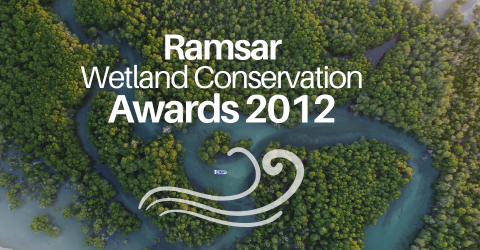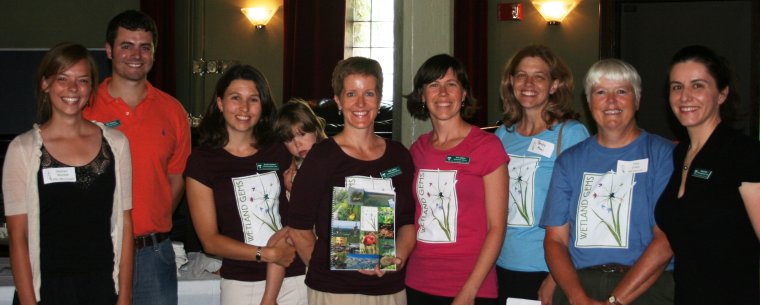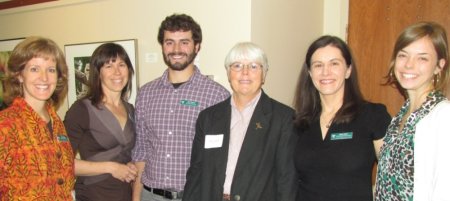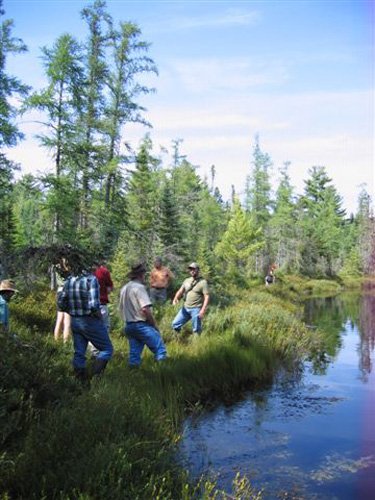
Award for Education 2012

The Wisconsin Wetlands Association, USA
The Wisconsin Wetlands Association (WWA) is a leader in communicating about, and promoting education, participation and awareness of wetlands and the Convention in the United States. WWA is a non-governmental organisation, founded in 1969, that is dedicated to the protection, restoration, and enjoyment of wetlands in the State of Wisconsin, through science-based programs, education and advocacy. For several years, WWA has incorporated the messages and values of the Convention in their wetland conservation, communication and awareness initiatives. WWA was instrumental in establishing a Wisconsin Ramsar Committee in 2009 to select priority sites in the state for nomination as Ramsar sites. On the basis of the WWA’s “Wisconsin Wetland Gems” program, the Committee identified twelve priority sites that meet the Convention's criteria to be submitted. Three sites have been or are being submitted to the US Fish & Wildlife Service for review. WWA’s strength also lies in strong communication and awareness programs focused on engaging participation of local communities and government bodies. In this respect WWA has successfully engaged local government officials to promote the integration of wetland conservation into existing development laws and regulations. WWA has also worked successfully with native communities. The Ramsar Wetland Conservation Award for Education is conferred upon the Wisconsin Wetlands Association in recognition of innovative and long-term initiatives which successfully include education, training, advocacy and research.
Interview with the Wisconsin Wetlands Association
Could you say something about the background and history of WWA?
The coalition that was the seed group for the Wisconsin Wetlands Association originated as the Dane County Wetlands Association in Madison, Wisconsin in 1969. Dane County is home to the capital city of Wisconsin, which is located between Lake Michigan and the Mississippi River in the Midwest region of the United States. At that time, a group of wetland enthusiasts was concerned about a planned highway development project that would cut right through the middle of some important urban wetlands near Madison. While the road was ultimately built across the wetlands, the work of these wetland enthusiasts did effectively result in a significant redesign of the road to minimize the impacts to the wetlands. These individuals saw the value in a citizen group to speak on behalf of wetlands, and the organization was born.
In 1977, the group changed its name to the Wisconsin Wetlands Association (WWA) so as to work at a broader level. The group was legally incorporated in 1992, hired its first paid staff member in 1993, and hired its first Executive Director in 1998. WWA currently employs four full-time and three part-time staff members and has a membership of nearly 1500. WWA does both education and advocacy work – education to help more people (including elected officials) understand the importance and value of wetlands and to promote wetland science and management, and advocacy in order to be a voice for wetlands in local, state, and national wetland decision-making.

We find that wetlands are often a forgotten resource. We hear people laud the importance of lakes rivers, prairies, and forests, but much less often remember wetlands. People talk about “lake edges” or “riparian forests” but do not recognize that these transitions between water and uplands are wetlands. We see our job as making sure that wetlands are part of the conversation.
We are also continually faced with the realization that public consciousness still holds a negative stereotype of wetlands. Wetlands are “wastelands.” They breed mosquitoes and other pests. Even the contemporary American language usage reflects this perception. What other valuable natural resource suffers from an ocean of such dubious expressions as “swamped”, “mired”, and “bogged down”? (These are all negative terms meaning “overloaded” or “stuck”.) These realities have inspired our work toward inspiring a change in the perception of wetlands from “wastelands” to “treasures”.
WWA is the first and oldest statewide wetlands conservation organization in the United States, and we are happy to hear that similar groups are now getting started in Michigan and Ohio.
Talk about your work with the Convention on Wetlands – can you say more about this, and about the Convention’s importance and impact in the USA?
Wisconsin Wetlands Association first became involved with the Convention in 2007 when our staff attended a Convention-focused session at a meeting of the Association of State Wetland Managers in the U.S. Seeing the connections between our work and goals and those of Convention, WWA eagerly joined the U.S. National Ramsar Committee at the invitation of then-chair Royal Gardner.
As part of the U.S. National Ramsar Committee, WWA committed to increasing the number of Ramsar Sites in the U.S. WWA began to look for ways that we could increase the profile of the Convention in Wisconsin and bring the prestigious Convention's designation to other worthy sites in the state. (At that time, Wisconsin was home to only one Ramsar Site, Horicon National Wildlife Refuge.)

(Photo by Becky Abel, North Central Region Wetland Gems Celebrated. See here.)
In 2009, WWA convened the Wisconsin Ramsar Committee, made up of wetland partners from federal agencies, state agencies, and non-governmental organizations. The committee was charged with developing a priority list for future nominations, and drew on work WWA had done as part of our Wetland Gems program. The 100 Wetland Gems sites are high-quality habitats that collectively represent the diversity of wetland types in each region of Wisconsin. The list of Wetland Gems built upon the results of several other extensive conservation planning projects that identified critical habitats. (Seewww.wisconsinwetlands.org/gems.htm to read more about our Wetland Gems program and site selection process.) We think of the Wetland Gems as “wetlands of statewide significance,” and thus saw a clear relationship to the Convention. The committee then helped to form nomination committees for the top three priority sites to put together materials for the Convention's designation. The nomination package for the first of these priority sites – which will be the first tribally-owned Ramsar Site in the U.S. if designated – was submitted to the USFWS in February of 2011, and we are told that a letter to the Secretariat of the Convention on Wetland recommending the designation is currently awaiting the signature of the USFWS Director.
We think the Convention’s importance and impact in the U.S. could be greater if more people were aware of and informed by the Convention’s work, and our efforts – both to promote the Convention within Wisconsin and through our work on the U.S. National Ramsar Committee – are directed at increasing that awareness.
Can you talk about the Convention’s technical and policy guidance work in the USA, why it is important, and how you see it facilitating the future of conservation work for wetlands?
Because our Convention-related work to date has mostly centered around general education and outreach about the importance and value of wetlands, we have not been in a position to utilize the Convention’s technical and policy guidance work thus far. That said, we are confident that there are resources that could be of use to our work, given the scientific credibility and know-how of individuals involved with the STRP and other Convention bodies. We encourage the Secretariat of the Convention and STRP to communicate with National Ramsar Committees around the world to help promote the work of the STRP and the tools and resources available to local organizations working for wetland protection.
How do you feel about receiving the Ramsar Award? How will you leverage this for the future of the work of WWA?
Wisconsin Wetlands Association is thrilled that our work to promote wetlands has received this prestigious recognition. We are honored and energized by the award, and hope our work will inspire others across the region, nation, and beyond to work on behalf of wetlands.
We will use news of this award as a “media hook” to enlist coverage of the issues and programs we support to bring attention to our programs and further build our organization’s credibility and name recognition within a larger audience. We also promote the award to attract and encourage the support of funders and our members so that we are able to raise even greater resources to support our work to protect and promote wetlands.

(Photo by Katie Beilfuss: Zach Wilson, Discovery Center Naturalist, led a field trip on the Center's bog boardwalk. See here.)
Do you have any general messages about the importance of wise use of wetlands?
We continually work to counteract the pervasive message that wetlands get in the way of development. We believe wholeheartedly that wetlands and human development can and must coexist. In fact, we believe that preserving wetland resources is essential for a healthy economy and a high quality of life.
In all of our work, we try to promote the understanding that, not only are wetlands critically important to biodiversity, they also provide our human communities with valuable functions and services including abating floods, helping to manage stormwater, and ensuring a clean water supply for fishing, swimming, and drinking. Without wetlands, human communities would need to engineer solutions to flood, stormwater, and clean water problems – solutions that typically cost much more to design, build, and manage than does protecting and managing wetlands. Wetlands should not be a dumping ground for pollutants and sedimentation. But they can and should be part of economically-viable solutions to water-related challenges in human communities.
Lastly, we believe that a connection to the natural world improves the physical, emotional, cultural, and spiritual well being of people. Wetlands are an important part of providing that connection.
How does “Ramsar” (Ramsar guidance material, principles, mission…) fit into the WWA philosophy and programme?
Wisconsin Wetlands Association is dedicated to the protection, restoration and enjoyment of wetlands and associated ecosystems through science-based programs, education and advocacy. Our programs are aimed at 1) increasing public awareness of wetland values and threats in order to motivate citizen participation in wetland protection, restoration and management; 2) protecting wetlands through effective advocacy by fostering citizen involvement in policy issues that affect wetlands; 3) building and mobilizing broad and diverse partnerships and a vibrant network of engaged and concerned citizens that support wetland protection; and 4) encouraging and facilitating restoration of our state’s damaged wetlands. All of these goals – applied at the statewide level – align with Convention’s global mission, the “conservation and wise use of wetlands … towards achieving sustainable development throughout the world.”
Wisconsin Wetlands Association has, for several years, incorporated the values and messages of the Convention into our wetland conservation, communication, and awareness initiatives, particularly through our outreach programs to the general public. One of these initiatives was developing what is believed to be the first strategic approach to identifying sites that qualify to be Wetlands of International Importance (discussed above). We are committed to working with our partners to facilitate the nomination of the 12 priority sites identified by the Wisconsin Ramsar Committee in the coming years. We have also worked to promote awareness of the Convention in our outreach work, both to a “general public” audience (through field trips and presentations) and to our wetland colleagues nationally (through professional conferences and the National Wetlands Newsletter published by the Environmental Law Institute).
WWA also works with local government officials to promote the integration of wetland conservation into existing development laws and regulations. We have completed an inventory and assessment of local regulations that affect wetland conservation, and developed recommendations for improving these programs. Local officials have been eager to work with WWA as partners in conserving wetland resources through greater regulatory efficiencies and better communication with private landowners about wetland regulations.
In your opinion, what are the most important aspects of your achievements that you would like to see highlighted in the context of the Ramsar Award?
We are very proud of this award, and are particularly proud of our initiative to increase the number of Ramsar Sites in Wisconsin through a strategic, pro-active, science-based approach. But the biggest prize will come when all of the priority sites in Wisconsin have been designated Wetlands of International Importance. We will then know the true value of this initiative. We also want to be sure to share credit for this award with our partners on the Wisconsin Ramsar Committee and those who own and manage these priority sites.
We do hope that the work that garnered this recognition will not only result in more designated Ramsar Sites in Wisconsin, but that it will also inspire other groups in the U.S. and around the world to use a similar approach to identifying and nominating sites for the Convention's designation. We also hope that designations will bring additional public awareness and funding to these new Wisconsin Ramsar Sites in order to further the important work to protect, restore, and manage them.
More Information:
Many photos from our Wetland Gems kickoff celebrations can be viewed at http://wisconsinwetlands.org/gemevents.htm#statewidelaunch. We would be happy to send you higher-resolution images of any of these photos for your use.
Wetland Gems: a program description, links to downloadable materials, and a list of the 100 Wetland Gems sites is available at http://wisconsinwetlands.org/gems.htm.
Our Ramsar initiative is described at http://wisconsinwetlands.org/Ramsar.htm.
We authored two columns in the National Wetlands Newsletter, one about Wetland Gems and another about the need to nominate more worthy U.S. sites for the Convention's designation. These can be found at: www.wisconsinwetlands.org/NWN-column11-09-Gems.pdf and www.wisconsinwetlands.org/NWN-column05-10-Ramsar.pdf (see the Communications section of each of these pdfs).
Check out a copy of our Wetland Gems book: You can read more about this book at http://wisconsinwetlands.org/gemsbook.htm